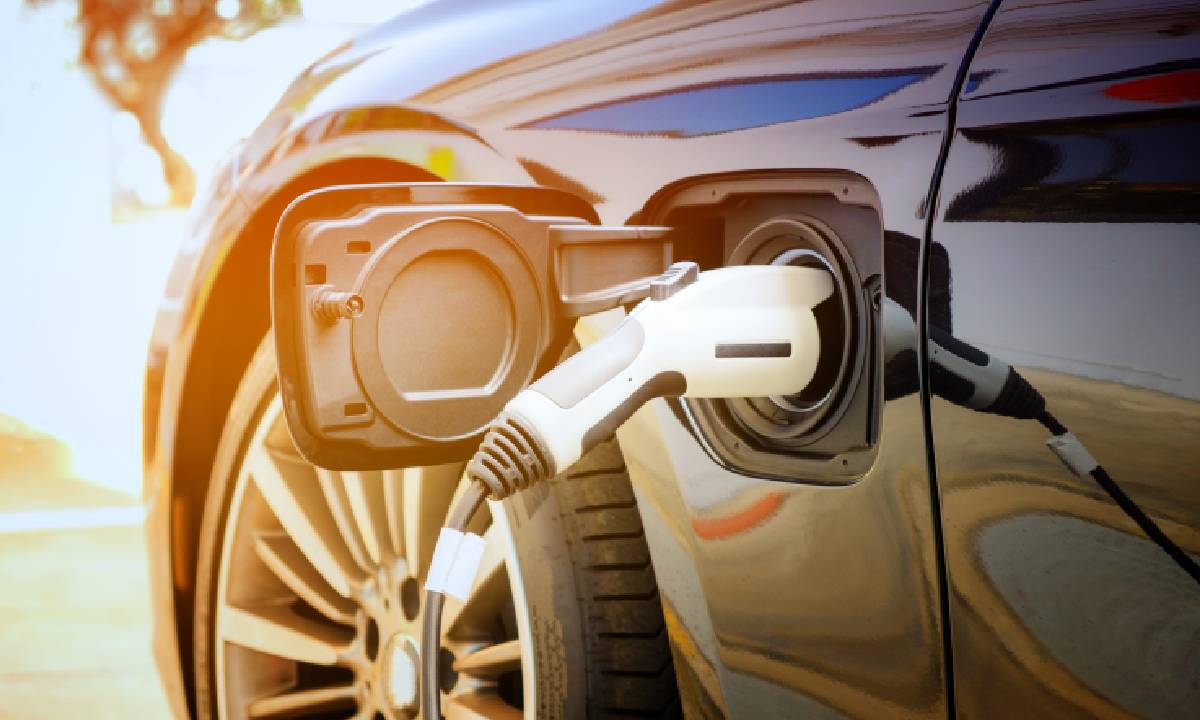Decarbonising the planet: Second-life lithium-ion batteries, vapour cloud explosions and elephants
17 April 2023 | By: Newcastle University | 5 min read
The United Nations estimate by 2050 more than 1 billion electric vehicles (EV) will be on the road. And it’s lithium-ion batteries (LiB) that are driving this rapid transition away from vehicles powered by fossil fuels.
These small, power-packed batteries are an essential part of decarbonising our planet, and, in just five years’ time, it’s predicted that 16,500 tonnes of EV LiB will be reaching their ‘end-of-life’.
Newcastle University’s Professor of Pure and Applied Electrochemistry, Paul Christensen, discusses how this swift adoption of LiBs has created a lag in our understanding of the risks and hazards — alongside the recycling infrastructure — of such power cells.
What is the purpose of your research?
My team and I focus on understanding thermal runaway and thermal propagation in LiB systems. This includes research into the risk management of the lifecycle of LiBs in EV cars.
This is not just to further our scientific understanding of these batteries. We use our research to inform first responders in terms of the best ways to deal with fire and explosions in such systems.
But I’m also on a mission to educate, too, as the safe use of LiBs is relevant to everyone.
What is a second-life battery?
LiBs in electric vehicles reach the end of their first life (in an EV) when they lose 20% of capacity, irreversibility. This is known as an 80% state of health (SoH).
But with the remaining 80% of battery capacity, they can still store lots of energy. No one really expected the first-life of these batteries to last so long. Neither did they foresee the potential to reuse the 80% SoH batteries.
Why is the use of second-life batteries important?
After reaching 80% SoH, these batteries are still very valuable. They also represent an expensive resource. If we didn’t look into how to adopt a second-life, they would more than likely be stock-piled or head to landfill. The materials recovery industry is still very nascent in the UK.
There are also lots of environmental reasons to avoid putting pollutants into the atmosphere, so there’s a major drive to use these batteries in second-life applications.
At present, these second-life applications primarily are in grid-scale battery energy storage systems (BESS). LiBs ideal for storing the intermittent electricity produced by renewable energy generators such as wind turbines and solar arrays.
Adoption in grid-scale BESSs could see LiBs having an extra seven to 10 years of life until they need to be recycled and materials recovered.
How did you become interested in the safety of second-life batteries?
In 2018, I started working on the ReLiB project funded by The Faraday Institution. Part of this project was trying to understand how long LiBs would last in second-life applications and how to recover valuable materials. This is when I became aware of LiBs starting fires in recycling facilities and fires and explosions involving EV and BESSs.
What are the two main views on second-life batteries?
My recent report for the Government’s Department for Business, Energy and Industrial Strategy (BEIS) concerned the safety of second life batteries in battery storage systems (Lithium-ion batteries).
It showed two opposing views on the safety of second-life EV batteries.
The first, was that a safety framework can be put in place to allow the use of second-life LiBs in domestic lithium-ion battery energy storage systems (DLiBESS). But it must have a full history of the batteries in their first life applications and/or they can be tested effectively.
The second, more radical view, was that second-life EV batteries couldn’t be safely re-used. The safety of such cells can never be guaranteed, and that second-life LiBs should not be employed under any circumstances in domestic Lithium-ion BESS.
My research was informed by discussions with representatives from over 30 organisations, including BESS and electric vehicle manufacturers and suppliers, industry associations, battery recyclers, research institutes, public and government bodies, product safety experts, and standards bodies.
What’s the elephant in the room?
With no widely-accepted test methodology for assessing the safety of second-life LiBs there’s a major gap in international standards.
Additionally, there remains uncertainty around the transportation of second-life LiBs. Part of my BEIS report addresses the urgent need to address this.
LiBs are classified as ‘dangerous goods’ under the UN28.3 – transporting dangerous goods. There are eight type tests that new LiBs must pass to be deemed safe. “Type tests” test a sample of batteries from a batch to destruction: if the sample batteries pass the tests the remainder are deemed safe to transport. This is fine for new LiBs due to the extremely high quality control during their production. However, type tests are not valid for second-life EV batteries as you can’t generalise safety across a batch of used batteries.
Both the International Electrotechnical Commission (IEC) and the British Standards Institute cite safety issues with the second-life use of LiBs and acknowledge the huge gap at present in the market.
But we are also facing another other issue.
In the UK, we don’t have a big enough material and recovery industry for second-life EV batteries.
Personally, I’m sceptical at present that we can prove the safety of second-life batteries. I’m very worried about the currently flourishing and unregulated trade in second-life batteries online and members of public making their own domestic BESSs. My research group and I undertook a number of experiments to help Fire and Rescue services deal with LiB fires and to further our understanding of thermal runaway.
What is thermal runaway?
At the present time, LiB fires and explosions involving e-scooters and e-bikes are killing and injuring people across the world as the LiBs are entering thermal runaway during charging.
Thermal runaway happens when overheating, over charging or damaging of the battery takes place.
This moves the cells into a dangerous state where they emit large volumes of toxic and flammable gases that, if ignited immediately, produce long rocket-like flames. If ignition doesn’t happen immediately, a vapour cloud appears and then explodes.
If your e-scooter goes into thermal runaway, there’s a 7.8% chance of you dying and 64% chance you’ll end up in hospital. This is all avoidable if you’re educated in LiB safety.
When EVs go into thermal runaway, the fires can burn for much longer than conventional vehicle fires, create toxic and explosive gases, and can reignite hours, days or weeks after the incident.

Image: infrared image taken during the overcharge of a Lithium-ion battery - the explosion
What are the main barriers to adoption of second-life batteries?
There are a number of barriers to address:
- uncertainty over codes and standards – transport and safety
- supply - companies can’t get enough batteries for the demand that’s coming through.
- there’s now a very narrow margin between the cost of a new vs second-life battery
- worries over safety
Do we need new safety standards for second-life batteries?
Yes, absolutely.
We have to use second-life EV batteries. Somebody, somewhere needs to grasp the nettle and develop codes and regulations around safe use and transportation.
There is good practice for us to learn from, including:
- The American standard UL 1974 standard is good, it’s not perfect, but it’s a starting point. It covers both inspection of the LiBs and testing. This standard shows that the state of safety of a battery isn’t wholly reliant on knowing the SoH of the battery. If it passes this, the LiB then needs to conform to another safety standard, UL 1973 - covering cell, module, pack and system.
- The German standard VDE-AR-E 2510 2021 includes a lot of good practice and common sense.
There is also the EU batteries regulation and the draft International Electrotechnical Committee (IEC) 63330 and 63338 standards, but at present I believe that these are not fit for purpose as they completely side-step the issue of safety testing.
How is your research influencing policy?
The work we do is certainly gaining attention from the BSI and other regulatory bodies. We advise:
- the Office for Zero Emission Vehicles
- the Department for Transport
- the Department for Energy
- a number of UK government working groups
- UK Chamber of Shipping
Why is Newcastle University well-placed to look at second-life batteries?
At Newcastle we have a unique blend of expertise across teams, not just scientists and engineers, but also with external agencies.
We have strong links with:
- fire and rescue and safety institutions across the world
- unique testing facilities supporting our area of research and the science of safety
- industry, including car manufacturers
- the Faraday Institution – where we are currently undertaking four battery-related projects, including ReLiB and SafeBatt
LiBs are an essential part in the decarbonisation of our energy systems. And, their potential for extending their battery life must be explored.
But, the development of the regulations and safety around second-life LiBs, alongside expanding the UK’s capacity in vital recycling chains, needs to be addressed - urgently.
Our research into what happens when such batteries fail, is continuing to expand our safety as we face a future of electrification.
You might also be interested in:
-
- More information about Professor Paul Christensen
- The Department for Business, Energy and Industrial Strategy recent report on Safety of second-life batteries in battery energy storage systems by Prof Christensen’s research
- the ReLiB project
- the SafeBatt project
- the International Electrotechnical Committee
- our latest press release about Newcastle University being involved in four Faraday Institution battery research projects aimed at delivering commercial impact.
- Latest news about our hybrid energy storage system in Singapore
- our Electrification Process Innovation Centre
- our Advanced Materials Electrochemical Engineering Research group
Find out more about the great work we're doing towards a net-zero future when you explore our blog. Alternatively, sign up to receive the latest insights and research stories directly to your inbox.
